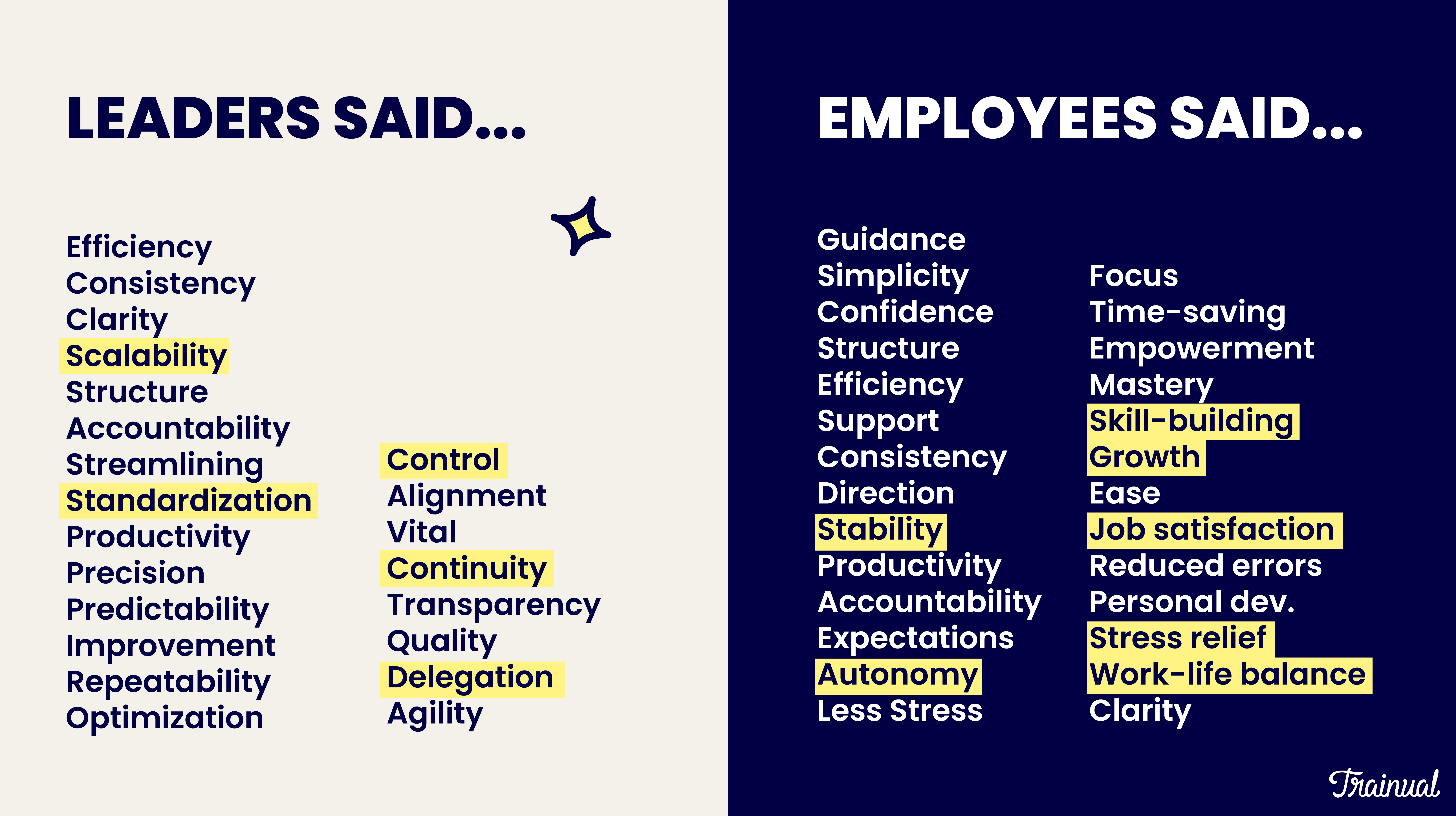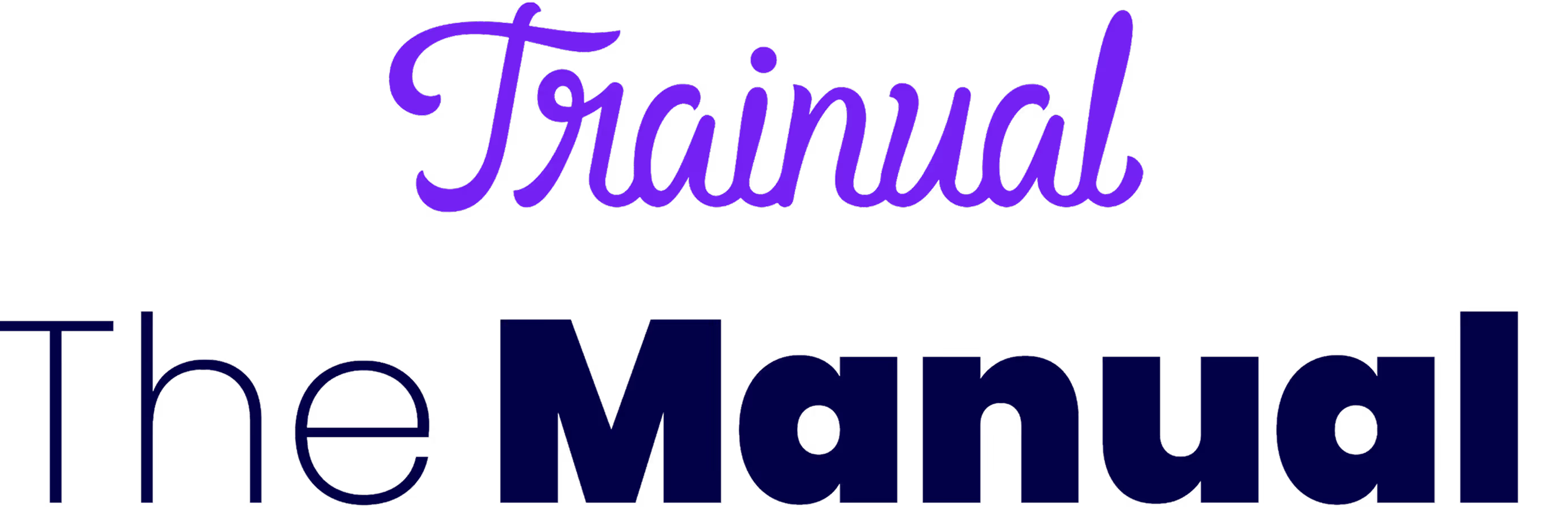
Articles
How To Get Your Team To Fall In Love With Process (And Our Best Hacks for Overcoming Objections)
September 18, 2025

Most teams don’t exactly love processes. The mere mention of “documented processes” can trigger eye rolls, heavy sighs, or a swift change in topic. But here’s the kicker — processes aren’t the problem.
How could they be? Nearly 50% of employees struggle to find documents, which costs them 20% of their workday! That’s not just time lost — it’s pure frustration.
That’s why tools like Trainual surface homepage reporting — training completion, active users, searches made. Paired with suggestions, these insights turn “bad” metrics into opportunities for growth instead of discouragement.
Process documentation clearly benefits both employees and the business — but if the advantages are so obvious, why does it still spark so much resistance?
Leaders and employees value processes for different reasons

When leaders weigh in on the perks of processes, they often sing the praises of scalability, standardization, control, continuity, and profitability. Sounds pretty solid, right? But hold on — when we turn to employees, their top hits include stability, autonomy, skill-building, job satisfaction, stress relief, and work-life balance.
Talk about a mismatch! There’s a clear divide between how leaders view processes and what employees actually value about them.
If you want your team to be fully onboard (See what we did there? 😉) with documenting and updating processes, you need to speak their L.O.V.E language. (AKA show them what’s in it for them.) When people see the personal benefits, they won’t just follow the processes — they’ll appreciate them.
What’s the L.O.V.E framework?
.png)
Processes don’t have to feel like red tape. They make work smoother, teams stronger, and businesses more efficient when done right. But getting people to embrace them? That’s the tricky part. Enter the L.O.V.E. framework — a simple, people-first approach to making process documentation something your team wants to standardize.
- L - Learn their motivators: Uncover what really drives your team. Plans and communications should be structured with their needs and desires top of mind.
- O - Overcome objections: Change can be hard. Confront blockers head-on by documenting and structuring processes in a way that directly addresses your team’s pain points (more on this to come).
- V - Voice and visibility: Give your team a say in shaping processes and ensure they're easy to access. When people have a hand in building something, they’re more likely to care about it — ownership drives continuity!
- E - Evolve with feedback loops: Keep things fresh by embedding continuous improvement into your company culture. Set up feedback loops to refine processes, and make recognition a habit — celebrate small wins and highlight process champions both internally and externally.
When you build processes with L.O.V.E., they become more than just rules on paper — they come to life, driving engagement, efficiency, and growth. But even the best frameworks can fall flat without leadership buy-in.
Systems and scalability start at the top
Let’s address the elephant in the room — when leadership isn’t fully bought in, process documentation and adherence fall flat. It’s a silent killer of efficiency, leading to frustration and inconsistency across teams.
Here’s the thing: Most employees won’t openly complain about a lack of organization or accountability at the top — they’ll just disengage.
Imagine this: one employee is all in, keeping their processes updated and creating a roadmap for anyone stepping into their role. But when they move to another team? They find outdated, ineffective processes that slow everything down. It’s demotivating. Why should they put in the effort if no one else is?
This resistance isn’t just about individual reluctance — it’s about culture. If employees see leadership disregarding documentation, they’ll follow suit. That’s why real change has to come from the top down. Leaders need to set the standard, reinforce the importance of documentation, and actively engage in the process. When they do, teams are far more likely to follow, turning process documentation from a dreaded task into an everyday habit.
But leadership buy-in is just one piece of the puzzle. Even with the best intentions, employees often resist change. Let’s break down the most common pushbacks — and how to address them head-on.
Here’s how to handle common pushbacks:
1. “We’ve always done it this way. Why change now?”
Why they resist: Change can feel like an unnecessary hassle when they don’t have a clear picture of how it benefits them long term. Sure, documenting processes takes time upfront, but it’s way less than what you lose by staying stuck in outdated practices.
✅ How to handle: Show how old processes create bottlenecks and tension. Frame process documentation as a path for growth, not a set of rigid rules. More organization means less stress — who doesn’t want that? Plus, when a process change makes things run smoother, guess who gets the credit? Yep, they do!
✨ Key motivators: Career growth, less stress, and long-term stability.
🎯 Take action: Highlight outdated processes causing inefficiencies and propose improvements. Show how it’ll free up time or reduce stress. Ask your team to do the same!
2. “I don’t like the process.”
Why they resist: Feeling unheard or frustrated with rigid systems can be a major barrier.
✅ How to handle: If someone doesn’t like a process, that’s good. It likely means it can be improved. Acknowledge their feedback and give them the keys to enhance the process rather than blindly following it. After all, who would rather stick to a process they know is flawed instead of one they helped improve?
✨ Key motivators: Voice, visibility, and a sense of ownership.
🎯 Take action: Create a feedback loop for employees to refine and enhance processes. At Chick-fil-A, franchise owner Scott built recognition right into the process. Anytime someone suggests a new idea or improves an existing workflow, they get called out and celebrated — turning process improvement into part of the culture.
3. “Who am I documenting this for? It feels pointless.”
Why they resist: They don’t see the value of their time and effort.
✅ How to handle: Clearly explain who will use the documentation and how it connects to the bigger picture. Show them the impact of their effort — especially when someone else has to take over when they’re out on PTO or when they move on to bigger and better things. Nobody wants to stress about handing off work when they’re out on vacation (or even worse during unplanned time away). And they definitely don’t want to be stuck in a role because they’re the only ones who know how to do it.
✨ Key motivators: Meaningful impact, career growth, stress reduction.
🎯 Take action: Share examples of how documented processes have helped others (cough, cough, Trainual customer success stories), or feel free to share your own experiences about how documented processes have helped you or someone else level up in their career.
4. “Processes change too fast — why bother documenting?”
Why they resist: They don’t want to waste time on something that will be outdated.
✅ How to handle: Highlight the importance of living documents that grow with the team. Show how a well-structured process can reduce growing pains by providing clarity and control. When documented properly, processes won’t need constant changes — but they will evolve with new tech and roles, and that’s a good thing! Think of it like mowing the lawn — the better you maintain your process library, the easier it is to refine when needed. Plus, you won’t have to overhaul it every week! Change isn’t a hassle — it’s a strategy.
✨ Key motivators: Stability, efficiency, and time savings.
🎯 Take action: Set aside one week every three to six months for your team to refine and update their processes.
5. “Processes kill creativity. I don’t want to be a robot.”
Why they resist: They fear processes will stifle innovation.
✅ How to handle: Reframe processes as guidelines, not handcuffs. A well-documented process can smooth out repetitive tasks, giving everyone more time to focus on creative problem-solving. Plus, getting organized boosts creativity and improves decisions so your team can do their best work!
✨ Key motivators: Autonomy, skill-building, and job satisfaction.
🎯 Take action: Show how structured processes free up time for more creative and strategic work. The best way to prove it? After a solid round of process documentation, schedule time for creative brainstorming or team connection. Go ahead—book it on the calendar and see the difference!
6. “There’s no consequence for not following the process, so why bother?”
Why they resist: Without accountability, processes get ignored.
✅ How to handle: Build reinforcement through recognition, rewards, and clear (documented) performance expectations. If individuals or teams know that process documentation and adherence are part of their annual review, there’s no mistaking that they are important to their long-term success in the company.
✨ Key motivators: Recognition, compensation, and career advancement.
🎯 Take action: Establish a system for recognizing and rewarding process champions (more on this below) and document clear expectations in their performance review. Propr leaned on a culture of gamification — and with Trainual’s new streaks and leaderboards, you can reinforce those same habits company-wide.
Bonus: Change champion program
Change champions are the secret sauce to making new processes stick, and giving them a shoutout can help your team (and company) grow! Not everyone can step into a leadership role, but a champion program shines a spotlight on your top performers and process advocates. When crafting an awesome process playbook, these champions bridge the gap between leadership and the team. Here are a few resources to get you started.
👉 Change champion program template.
🎯 Take action: Identify and empower change champions within your team and leverage our resources to jumpstart the program!
A few things to remember

The process is the foundation, not the restriction. It’s people who make processes successful. We have to set expectations and allow our top performers to exceed them.
If you want your team to embrace processes truly, change the narrative from “this benefits the company” to “this makes your job easier, more fulfilling, and less stressful.”
When you shift the narrative from processes being a burdensome task that only benefits the company’s bottomline to an empowering resource created in their best interest, your team will not only follow them — they’ll champion them. This is how you get your team not just to accept processes but truly fall in love with them.
👉 Ready to discover what Trainual can do for your business? Get a demo today.
Have questions? Contact support.
Still hitting roadblocks? Let's figure it out together. Contact the Trainual team at support@trainual.com or help.trainual.com, and we’ll help you sort it out.
Similar Blog Posts








